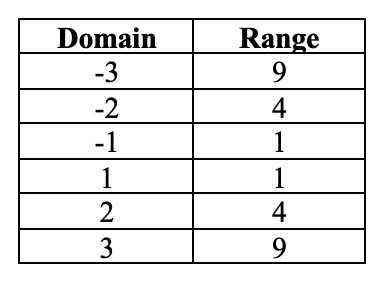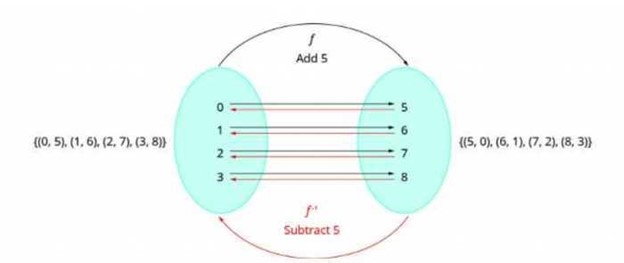One to One Functions - Graph, Examples | Horizontal Line Test
What is a One to One Function?
A one-to-one function is a mathematical function in which each input correlates to a single output. So, for each x, there is only one y and vice versa. This means that the graph of a one-to-one function will never intersect.
The input value in a one-to-one function is noted as the domain of the function, and the output value is noted as the range of the function.
Let's examine the examples below:

For f(x), any value in the left circle corresponds to a unique value in the right circle. In conjunction, each value on the right side corresponds to a unique value in the left circle. In mathematical words, this signifies every domain holds a unique range, and every range has a unique domain. Hence, this is an example of a one-to-one function.
Here are some additional representations of one-to-one functions:
-
f(x) = x + 1
-
f(x) = 2x
Now let's look at the second example, which exhibits the values for g(x).
Be aware of the fact that the inputs in the left circle (domain) do not hold unique outputs in the right circle (range). Case in point, the inputs -2 and 2 have identical output, in other words, 4. Similarly, the inputs -4 and 4 have equal output, i.e., 16. We can comprehend that there are matching Y values for many X values. Therefore, this is not a one-to-one function.
Here are different representations of non one-to-one functions:
-
f(x) = x^2
-
f(x)=(x+2)^2
What are the properties of One to One Functions?
One-to-one functions have these characteristics:
-
The function owns an inverse.
-
The graph of the function is a line that does not intersect itself.
-
It passes the horizontal line test.
-
The graph of a function and its inverse are equivalent regarding the line y = x.
How to Graph a One to One Function
When trying to graph a one-to-one function, you will need to find the domain and range for the function. Let's look at a simple example of a function f(x) = x + 1.

As soon as you have the domain and the range for the function, you need to plot the domain values on the X-axis and range values on the Y-axis.
How can you evaluate whether a Function is One to One?
To indicate whether a function is one-to-one, we can leverage the horizontal line test. Once you graph the graph of a function, draw horizontal lines over the graph. If a horizontal line intersects the graph of the function at more than one point, then the function is not one-to-one.
Due to the fact that the graph of every linear function is a straight line, and a horizontal line will not intersect the graph at more than one place, we can also deduct all linear functions are one-to-one functions. Remember that we do not use the vertical line test for one-to-one functions.
Let's study the graph for f(x) = x + 1. Immediately after you graph the values for the x-coordinates and y-coordinates, you need to review whether or not a horizontal line intersects the graph at more than one place. In this case, the graph does not intersect any horizontal line more than once. This indicates that the function is a one-to-one function.

Subsequently, if the function is not a one-to-one function, it will intersect the same horizontal line multiple times. Let's study the graph for the f(y) = y^2. Here are the domain and the range values for the function:

Here is the graph for the function:

In this instance, the graph crosses multiple horizontal lines. For example, for either domains -1 and 1, the range is 1. In the same manner, for each -2 and 2, the range is 4. This signifies that f(x) = x^2 is not a one-to-one function.
What is the opposite of a One-to-One Function?
Considering the fact that a one-to-one function has a single input value for each output value, the inverse of a one-to-one function also happens to be a one-to-one function. The opposite of the function essentially undoes the function.
For Instance, in the case of f(x) = x + 1, we add 1 to each value of x as a means of getting the output, or y. The opposite of this function will deduct 1 from each value of y.
The inverse of the function is known as f−1.
What are the properties of the inverse of a One to One Function?
The properties of an inverse one-to-one function are identical to every other one-to-one functions. This means that the reverse of a one-to-one function will possess one domain for each range and pass the horizontal line test.
How do you determine the inverse of a One-to-One Function?
Finding the inverse of a function is simple. You simply need to swap the x and y values. Case in point, the inverse of the function f(x) = x + 5 is f-1(x) = x - 5.

As we reviewed previously, the inverse of a one-to-one function reverses the function. Considering the original output value showed us we needed to add 5 to each input value, the new output value will require us to deduct 5 from each input value.
One to One Function Practice Examples
Contemplate the following functions:
-
f(x) = x + 1
-
f(x) = 2x
-
f(x) = x2
-
f(x) = 3x - 2
-
f(x) = |x|
-
g(x) = 2x + 1
-
h(x) = x/2 - 1
-
j(x) = √x
-
k(x) = (x + 2)/(x - 2)
-
l(x) = 3√x
-
m(x) = 5 - x
For every function:
1. Figure out if the function is one-to-one.
2. Plot the function and its inverse.
3. Determine the inverse of the function algebraically.
4. State the domain and range of both the function and its inverse.
5. Apply the inverse to determine the value for x in each formula.
Grade Potential Can Help You Learn You Functions
If you find yourself facing difficulties trying to learn one-to-one functions or similar topics, Grade Potential can set you up with a one on one instructor who can help. Our Akron math tutors are skilled professionals who support students just like you improve their skills of these types of functions.
With Grade Potential, you can work at your own pace from the convenience of your own home. Schedule a call with Grade Potential today by calling (330) 632-3388 to find out more about our educational services. One of our consultants will get in touch with you to better determine your needs to find the best teacher for you!




